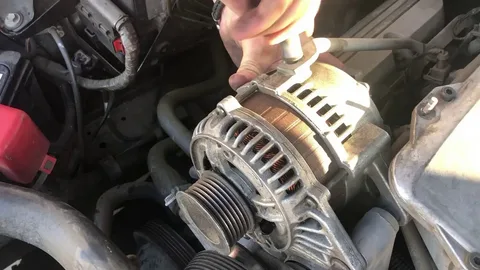You know how much it can handle if you own a Suzuki Carry. It’s the ultimate workhorse, from hauling goods to navigating tight city streets. This small but mighty component is crucial for keeping everything running smoothly, from powering up lights to charging your battery. If you’re noticing flickering headlights or struggling with electrical issues, it might be time for an upgrade. Buckle up as we explore everything you need to know about upgrading your Suzuki Carry alternator and ensuring that this little powerhouse continues to perform at its best!
Understanding the Importance of the Alternator in Your Suzuki Carry
The alternator is often the unsung hero of your Suzuki Carry. While you may not give it much thought, this crucial component keeps everything in harmony. It transforms mechanical energy into electrical energy, ensuring that all electrical systems remain powered up and running.
Imagine driving on a dark road without lights or listening to your favourite tunes without sound. That’s what happens when the alternator falters. Its primary role is charging the battery while operating various electrical accessories like headlights, wipers, and air conditioning.
When you’re hauling heavy loads or navigating through city traffic, the demand for power increases significantly. Your alternator rises to meet those demands by providing consistent voltage. A well-functioning alternator guarantees that each journey goes off without a hitch.
Moreover, an upgraded alternator can enhance performance and reliability, especially if you’ve customised your Suzuki Carry with additional electronics or accessories. This ensures you have enough juice for every gadget you throw at it.
Understanding the importance of your Suzuki alternator can lead to better maintenance decisions and a more enjoyable driving experience overall.
Signs Your Suzuki Alternator Needs Upgrading
Your Suzuki Carry is a dependable workhorse, but you might notice some telltale signs when its alternator starts to falter. The first clue often comes from your dashboard. If the battery warning light flickers or stays illuminated, it’s time to pay attention.
Next up are power issues. If your headlights dim unexpectedly or struggle to shine brightly, that may indicate an alternator on the brink. This could also affect other electrical components like power windows and radio systems—an undeniable signal that something isn’t right.
Strange noises can be another indicator. A failing alternator might produce grinding sounds or whining as the bearings break down. It’s not just annoying; it’s a sign that immediate action is needed.
You should also watch for unusual smells—like burning rubber or hot wires—indicating overheating in your electrical system due to an overworked alternator.
If you’re experiencing frequent dead batteries despite regular replacements, this could mean your Suzuki Carry’s alternator isn’t delivering enough charge anymore; it’s begging for an upgrade!
Choosing the Right Alternator Upgrade for Your Suzuki Carry
When considering an alternator upgrade for your Suzuki Carry, it’s essential to assess your specific needs. Are you planning on adding extra electrical accessories, such as a sound system or additional lighting? These factors will determine the type of alternator that suits you best.
Not all alternators are created equal. Upgrading means exploring options like high-output models designed to handle increased loads. Look for brands known for quality and reliability, as this component is crucial to your vehicle’s performance.
Compatibility matters too! Ensure the alternator fits seamlessly into your Suzuki Carry’s existing setup. Check specifications meticulously – mismatches can lead to frustrating issues down the line.
Don’t overlook customer reviews and ratings before making a decision. Real-world experiences can provide insight into durability and efficiency, guiding you toward the right choice.
Consider warranty offerings from manufacturers. A solid warranty protects your investment and gives you peace of mind, knowing help is available should any issues arise with your new Suzuki alternator upgrade.
Upgrading Your G13BB Alternator
Upgrading your alternator can transform the performance of your Suzuki Carry. This small yet mighty component significantly powers all electrical systems, ensuring that your vehicle runs smoothly. When you decide to upgrade, consider what benefits you’re after.
First and foremost, an upgraded alternator provides more power output. This boost is crucial if you’ve added aftermarket accessories or need extra juice for heavy-duty tasks. The right upgrade will easily meet increased demands without straining other components.
Next comes reliability; older alternators tend to wear down over time. By upgrading to a newer model, you invest in longevity and peace of mind on every journey. A robust G13BB Alternator means fewer surprises when you’re on the road.
Remember efficiency! Modern alternatives often have improved designs that reduce energy loss during operation. This not only helps protect your battery but can also lead to better fuel efficiency—a win-win for any driver.
Installation options are plentiful! Many manufacturers offer plug-and-play solutions tailored specifically for G13BB engines—the perfect way to enhance performance without unnecessary hassle.
Tips for Maintaining Your Upgraded Suzuki Alternator
Maintaining your upgraded Suzuki alternator can significantly extend its lifespan and enhance performance. Start with regular visual inspections. Look for signs of wear or damage, such as frayed wires or corrosion on terminals. Catching issues early can save you headaches down the road.
Next, keep the electrical connections clean and tight. Dirty or loose connections can lead to voltage drops that affect your alternator’s efficiency. Use a soft cloth to wipe away dirt, and ensure that bolts are securely fastened but not over-tightened.
Monitor battery health regularly too! A strong battery helps your alternator work less hard, which lasts longer. Check fluid levels and look for cracks in the casing or leaks around terminals.
Consider using high-quality replacement parts whenever maintenance is needed. They often outperform cheaper alternatives in terms of durability and reliability. Investing a bit more now can prevent costly repairs later.
Remember, periodic professional check-ups. Technicians have tools that detect underlying issues you might miss during routine checks, ensuring your Suzuki Carry runs smoothly for years to come!
Installation Process of the Alternator
Installing a new Suzuki alternator can seem daunting, but with the right steps, it’s manageable. First, you’ll need to gather your tools. A wrench set, socket set, and basic hand tools will be essential for this task. Don’t forget safety goggles!
Start by disconnecting the negative battery terminal. This small step is crucial; it prevents any electrical mishaps while you’re working on the alternator. Once that’s done, locate the old alternator under the hood of your Suzuki Carry.
Next up: unbolt it! Carefully remove the wiring harnesses connected to your old alternator—these can sometimes be tricky due to age or corrosion. Once everything is disconnected, unscrew those mounting bolts and gently lift out the old unit.
Now it’s time for installation! Position your new Suzuki alternator in place and secure it with the bolts you removed earlier. Reattach all wiring harnesses snugly to ensure perfect connectivity.
Before finishing up, reconnect that negative battery terminal and quickly check everything around it for loose ends or tools left behind. Start her up diligently with all steps followed; listen for that smooth purr of power flowing through!
Cost of Repairing Alternator
When it comes to the cost of repairing your Suzuki alternator, several factors are involved. First, the type of repair needed can vary significantly. A simple fix like replacing a diode or belt might cost you less than a hundred dollars. However, prepare for higher costs if you want a complete replacement.
Labour charges also add to the overall expense. Mechanics often charge hourly rates that range from $75 to $150, depending on their expertise and location. Expect additional labour hours and costs if your alternator is nestled deep within an engine compartment.
Parts pricing is another crucial piece of the puzzle. Aftermarket parts are more affordable than OEM (Original Equipment Manufacturer) components but come with varying quality levels—something worth considering in your decision-making process.
Remember about diagnostic fees, too; some shops charge just to tell you what’s wrong before any work begins!
Always factor in potential hidden problems discovered during repairs, which could further inflate those initial estimates.
Conclusion
Upgrading your Suzuki Carry alternator is more than just a necessary repair; it’s an enhancement that can transform your driving experience. A reliable alternator ensures that all electrical components function seamlessly, from headlights to infotainment systems. When you plunge into this upgrade, you invest in performance and longevity. This means fewer breakdowns and unexpected issues on the road, allowing you to focus on what truly matters—your journey. With so many options available for upgrades, it’s essential to choose wisely. Researching compatibility with your specific model can improve efficiency and even power output.
FAQS
What are the common signs that my Suzuki alternator is failing?
Look for signs of dimming headlights, electrical issues, or unusual noises under the hood. If your battery warning light appears on the dashboard, it’s also a good indicator.
How do I choose an upgraded alternator for my Suzuki Carry?
Research reputable brands that are known for quality and compatibility with your model. Consider factors like output capacity and warranty options.
Can I install a new Suzuki Carry alternator myself?
If you have basic mechanical skills and tools, DIY installation of the Suzuki Carry alternator is possible. However, seeking professional help can save time and prevent mistakes if you’re unsure or inexperienced.
What maintenance does an upgraded alternator require?
Regularly check connections for corrosion or looseness. Keep belts aligned correctly to ensure optimal performance without undue stress on components.
How much should I expect to spend on upgrading my alternator?
Costs vary depending on part quality and labour fees if you hire someone. Generally speaking, budgeting between $100 and $400 will adequately cover most scenarios.
| Related Business Listings |
| Contact Directory |
| Local Business Profiles |




